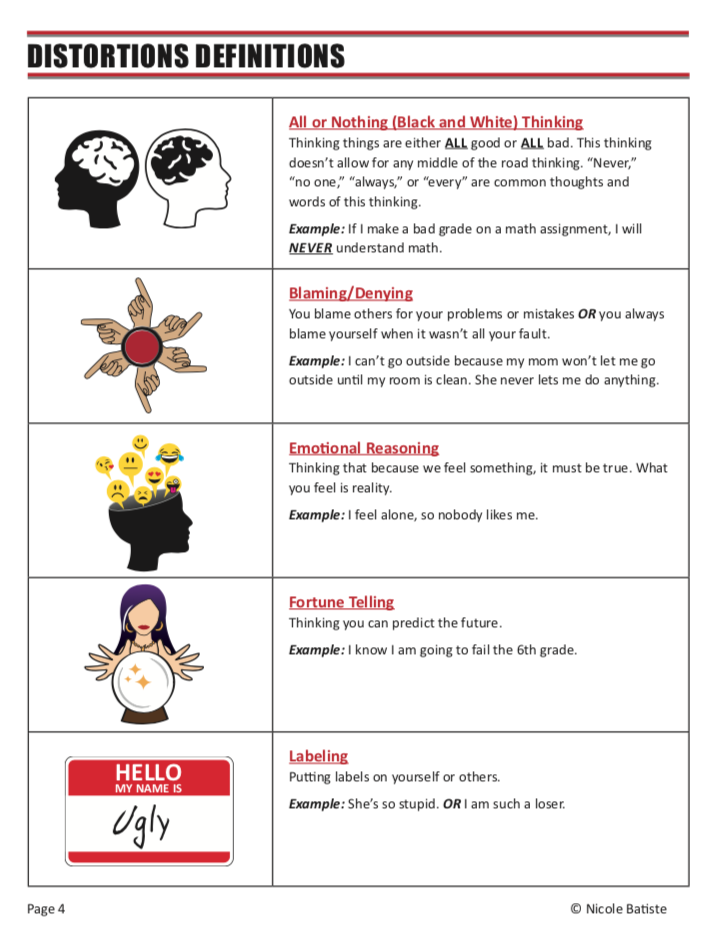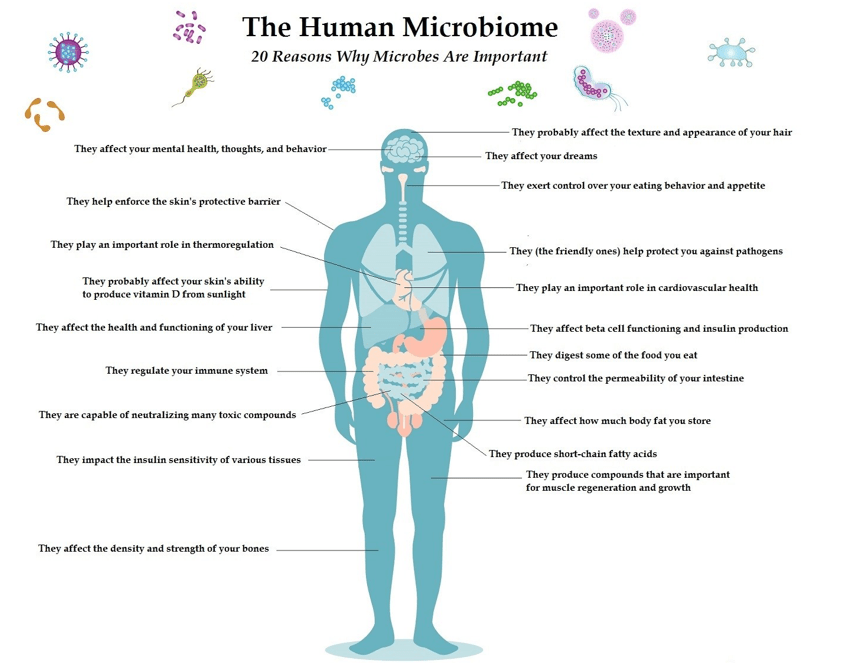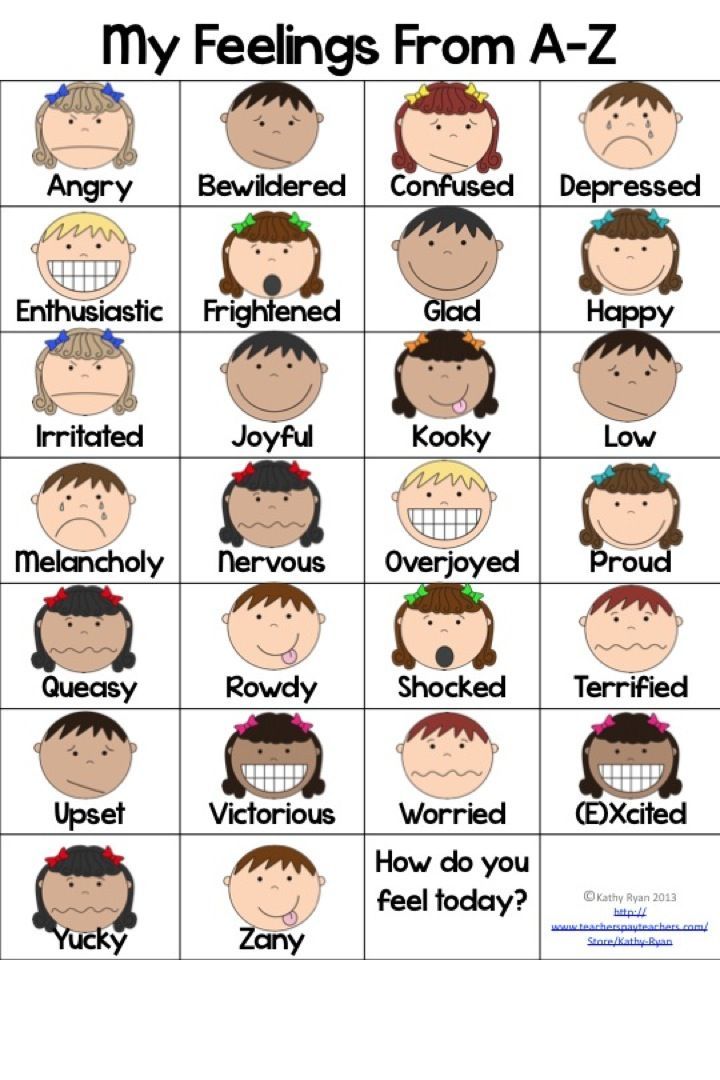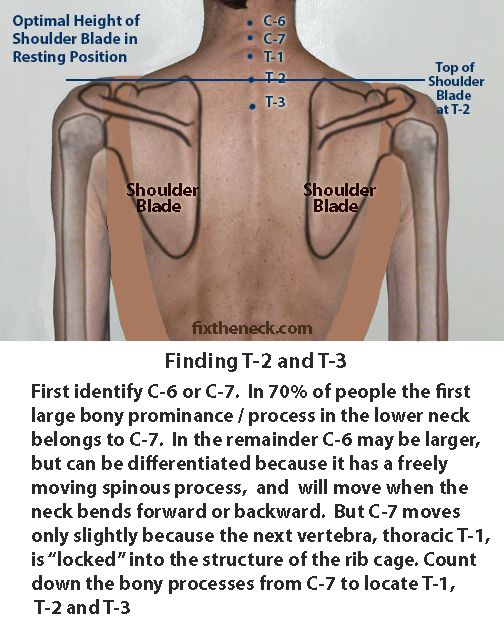All or nothing thinking worksheet
7 Steps To Crush All-Or-Nothing Thinking (With Worksheet)
Do these thoughts ever cross your mind?
- If I can’t give this 100% of my time and attention, then it’s not going to work.
- I am completely overwhelmed, I need to stop until I have more time.
- If I can’t be perfect, why bother?
When you start a plan to get fit, do you feel like you are either all-in or all-out? That there’s no middle ground?
If so, you’ve fallen into the trap of all-or-nothing thinking. And the single biggest roadblock in your way is…your mindset.
But what if you could change that? What would be possible if your health wasn’t dependent on your job, life, or you being perfect?
That’s what we’re going to talk about today!
I am going to give you a step-by-step strategy to challenge and change your thoughts, beliefs, and attitudes.
In fact, these are the exact same steps I use to challenge my thoughts and escape the self-sabotaging grip of all-or-nothing thinking.
But:
Before we dive into the strategy, let’s start from the beginning.
What Is All-Or-Nothing Thinking?All-or-nothing thinking is when you see things in absolutes. It’s either black or white, right or wrong, on or off. There is no in-between and no shades of gray.
A client once told me, “I have a work trip coming up, and I always eat terrible away from home. I need to put this program on pause until I get back and can focus.”
This is a perfect example of thinking in absolutes. Notice they said they “always” eat terrible.
Imagine you head into a trip thinking your meals are going to be a train wreck. How well will you eat?
If you believe you will eat terrible, then you will. It’s a self-fulfilling prophecy. You will prove yourself right.
Another client said, “If I can’t devote 100% of my time and attention to getting fit, then I just can’t stick to it.”
This is another example of the all-or-nothing snare.
But:
Is it true that the sun and stars have to align for you to stick to a diet? That if everything isn’t perfect, what’s the point of trying? Of course not.
Unless…you believe things must be perfect.
The fact is there’s no such thing as the ideal time, and things will never be “just right.”
But when you’re in the grips of all-or-nothing thinking, it feels like you’re trapped in a dark room with no way out.
So what is all-or-nothing thinking?
Technically speaking, it is a cognitive distortion.
- Cognitive meaning the way you understand, think, and perceive. And,
- Distortion meaning misleading or irrational.
Put another way, all-or-nothing thinking is a false or inaccurate view of the situation and the world around you.
The Dangers Of All-Or-Nothing ThinkingWhen getting fit is what you’re shooting for, black and white thinking will derail even the best effort to stay on track.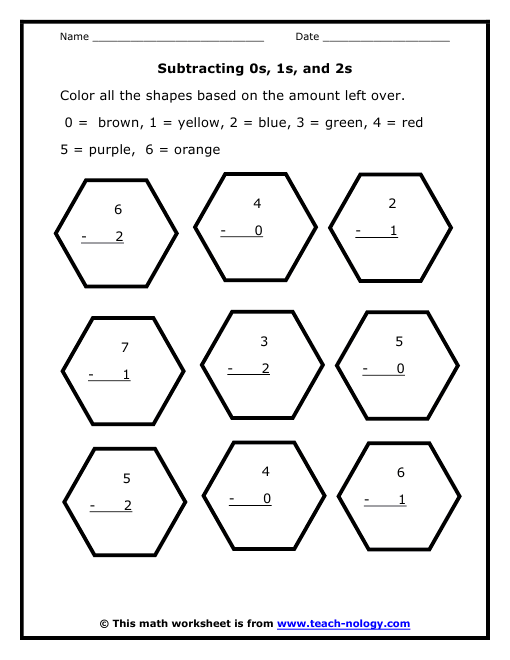 One minute you’re on fire and nothing can stop you. It’s all salads, chicken, and hour-long sweat sessions.
One minute you’re on fire and nothing can stop you. It’s all salads, chicken, and hour-long sweat sessions.
But then, you sleep through the alarm and miss breakfast. You’re starving, so you pull into the drive-through and grab a couple of fried chicken biscuits.
Not a big deal, right?
But, if you’re either all-in or all-out, your whole diet is shot!
“Well, today is over. Heck, this whole week is a wash! I’ll start again Monday.”
So what are the dangers of all-or-nothing thinking?
1.) You’re Setting Yourself Up For Failure.
There are no perfect days, meals, or workouts. So when your expectation is a flawless day, anything less is a failure.
2.) The Pressure Is Absolutely Crushing.
Unrealistic expectations are the chains you place on yourself. Sure, we all want to be great and successful. But, the weight you’re carrying is enough to make the best of us fold and walk away.
3.) It’s A Vicious Cycle Of Stalling, Starting, And Stopping.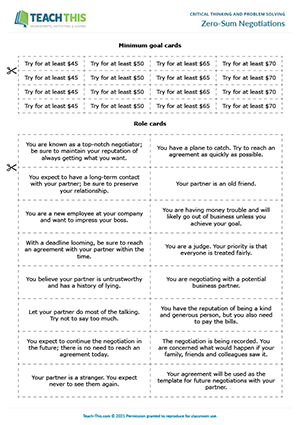
All-or-nothing thinking has many different faces, but at its core, it is a self-sabotaging mindset.
If you’re waiting for the right time and motivation, one of two things happen:
- You never cross the starting line. You keep waiting for the right time to show up, but it never does.
- You get caught in the start and stop loop. You finally get a boost of motivation. BUT, the minute things get hectic or don’t feel perfect anymore, you slam on the brakes.
The problem with all-or-nothing thinking is that it is a trap. One that research shows us has strong ties to:
- Anxiety,
- Depression,
- Low self-esteem,
- Self-criticism,
- A negative body image, and
- Eating disorders, such as obesity and anorexia.
But to be fair, there ARE advantages to all-or-nothing thinking. And that’s why it is so hard to let go! (We’ll get to that soon.)
7 Steps To Beat All-Or-Nothing ThinkingTo break free from of the all-or-nothing mindset, it’s key to understand the connection between Thoughts, Emotions, and Actions.
- Thoughts have an impact on the emotions you feel and the actions you take,
- Emotions affect your thoughts and actions, and
- Actions influence your thoughts and emotions.
(The relationship between thoughts, emotions, and actions is at the core of Cognitive Behavioral Therapy)
Let’s look at how the relationship between these three play out in a common scenario.
Here’s the situation….
It’s Monday morning, and today is the first day of your new diet. Your expectations are high, but so is motivation. You are fired up and ready to charge into this!
Day 1 is a breeze. You wake up before the sun to crack eggs, pack lunch, and tie your laces before jogging a few miles. At the end of the day, you think, “Wow, today actually felt pretty easy!”
As Day 2 comes to a close you realize that today was even better than yesterday. At lunch, your friends ordered burgers and fries, but you stuck to leafy greens and protein.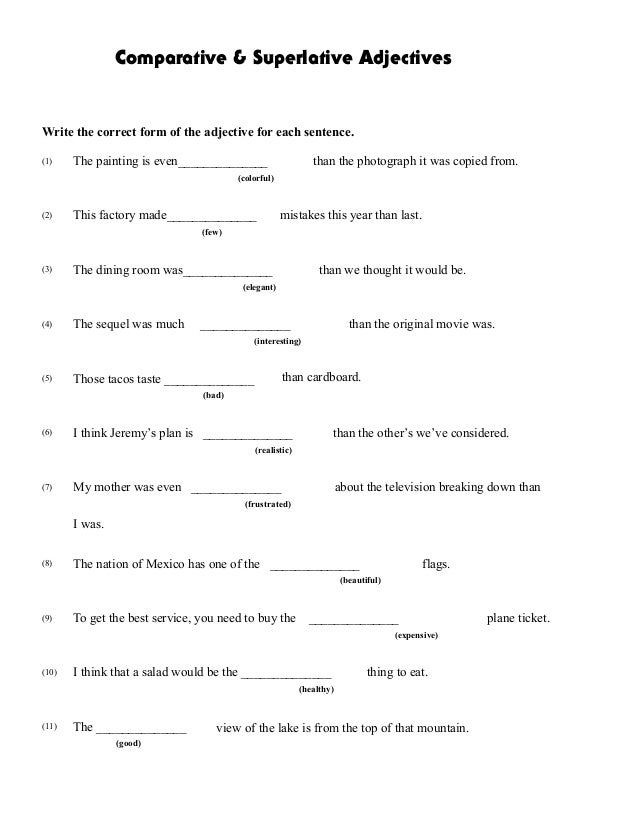 There are no two ways about it. You are on fire!
There are no two ways about it. You are on fire!
Two weeks in and you are still going strong. In fact, we could describe things up to this point as, well…perfect!
But that’s when you hit a snag. Your job was going smooth, then two new projects land in your lap.
Any time you had to focus on your health is gone! Now, there’s no time to eat lunch, let alone go to the gym.
And the thought running through your mind is, “It is impossible to keep this diet going. I’ll start again when I can give it my full attention.”
This is the scenario we’ll use to walk through the 7 steps to change all-or-nothing thinking.
- Learn to spot all-or-nothing thinking.
- Describe the situation.
- Capture the stories you tell.
- Pinpoint the emotions your story triggers.
- Describe the result of your thoughts and emotions.
- Challenge your initial thought.
- Choose a new thought.
(Download the worksheet to practice changing your mindset.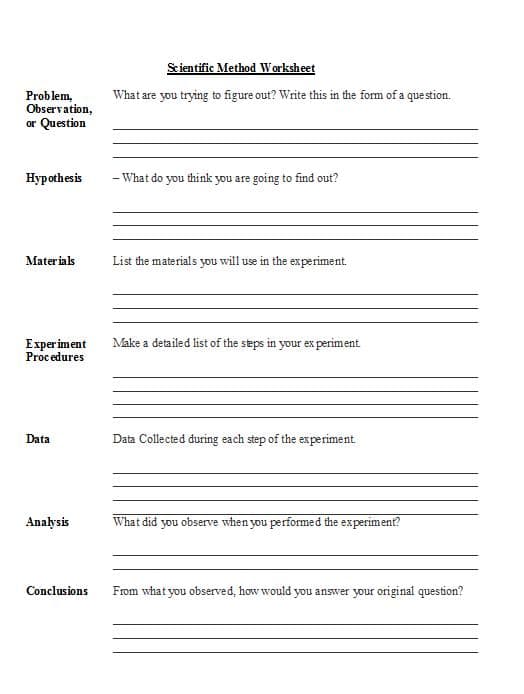 )
)
Are you ready? Let’s jump in!
Step 1: Learn to spot All-Or-Nothing thinkingBefore you can change self-sabotaging thoughts, you must first learn to spot them.
How do you do that? Research shows one way to shine a spotlight on negative thoughts is to be aware of the language you use.
Whether you’re talking to others or yourself, pay attention to keywords like: always, never, impossible, perfect, or ruined.
Here are examples of all-or-nothing language in action:
- I eat great during the day, but “always” binge at night.
- I “never” make it more than three weeks into a diet before it all comes crashing down.
- Now is not a good time. There’s too much happening. I’m waiting for the “perfect” time to start.
- I just downed a row of Oreos. Well, I guess my diet is “ruined.”
And, going back to the scenario above, the all-or-nothing language was:
“It is impossible to keep this diet going now. I’ll start again when I can give it my full attention.”
I’ll start again when I can give it my full attention.”
Catching yourself using all-or-nothing keywords takes practice.
If you’re looking to get fit, becoming aware and changing this type of thinking is exactly what our program can help you with.
Step 2: Describe the situation.In this step, we’ll briefly describe the situation or circumstance that led to your thought.
You don’t have to write down everything that happened, just the facts.
This step is critical in learning more about the patterns or events that trigger negative thinking. Triggers like:
- The pressure at work or school is mounting,
- You put off a project until the last minute,
- You woke up late,
- You had an argument at home,
Or, like in our example, the situation was: you took on two new projects.
Step 3: Capture the stories you tell.In this step, you will capture the thought you had immediately after the triggering event.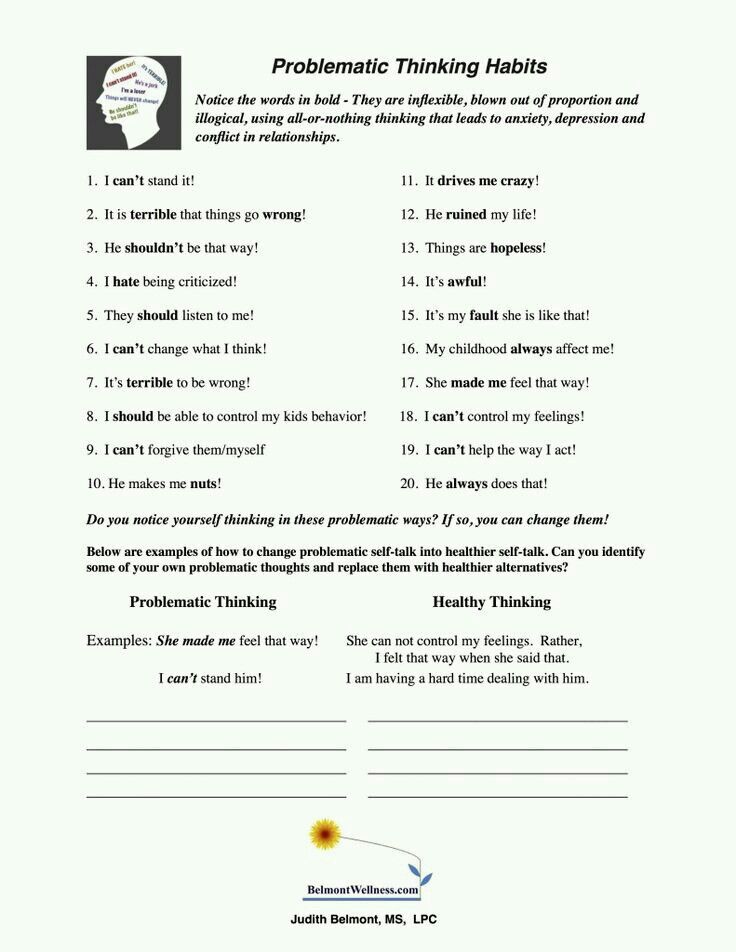 This thought was likely subconscious or automatic.
This thought was likely subconscious or automatic.
Keep in mind, you likely have more than one thought to write down.
In addition to, “It is impossible to keep this diet going now. I’ll start again when I can give it my full attention.”
You might also think, “This always happens! That’s why I’ve never been able to stick to a diet.”
Notice the all-or-nothing keywords “always” and “never” in the second thought.
Step 4: Pinpoint the emotions your story triggers.In this step, describe the feelings or emotions your thought created.
Maybe you feel overwhelmed, frustrated, angry, or despair.
- Overwhelmed – from the amount of work on your plate.
- Frustrated – that this diet is turning out to be another failed attempt.
- Angry – at yourself that you can’t manage to conjure the willpower to keep it going.
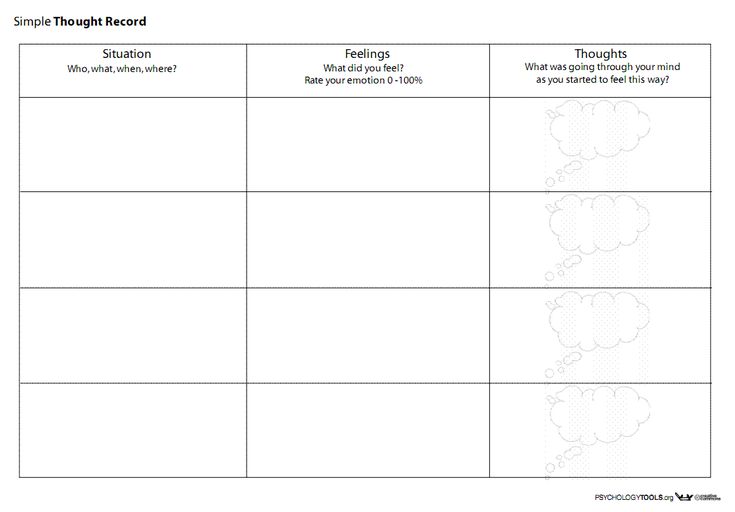
- Despair – that something always seems to get in the way.
And maybe you even felt a sense of relief.
- Relief – that you can finally come up for air and avoid the discomfort of change. (I point this out because I have felt that exact same relief from calling it quits.)
Whatever emotion you are feeling, write it down!
Step 5: Describe the result of your thoughts and emotions.Let’s pause to recap where we are.
You finished two solid weeks on your diet, and everything was amazing until you were handed two new projects. You had time to focus on you and your health, but now that time is gone.
Your thought was, “It is impossible to keep this diet going. I’ll start again when I have time to give it my full attention.” And that thought triggered feelings of being overwhelmed, frustrated, and angry, along with despair.
Now, when you look at the action you take as a result of your Thoughts and Emotions, it’s easy to see what will happen next: You quit your diet.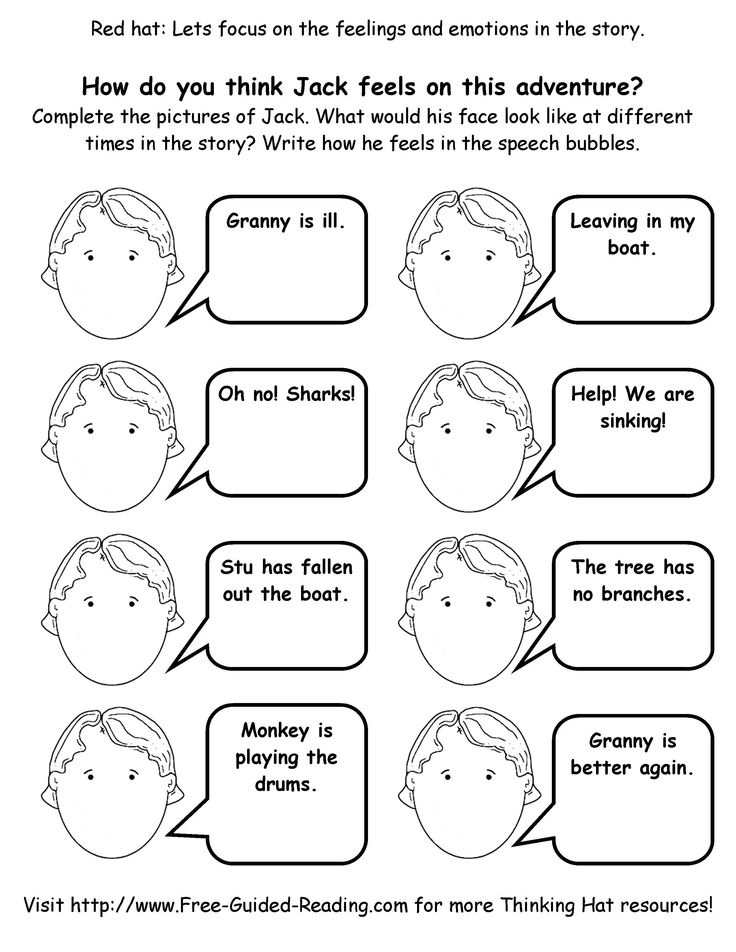
And once we see how the actions we take are a result of our Thoughts + Emotions, the question becomes, How do you change your Thoughts?
Changing your Thoughts creates different Emotions. Emotions that will drive the results you actually want.
To change your initial thoughts you must challenge and replace them with an alternate thought.
6.) Challenge your initial thoughts.To challenge your thought, ask questions like:
- Is this thought a true statement?
- Is it really impossible to stick to your diet?
- Does success really mean you have to dedicate 100% of your time and attention?
- Is there anyone in a position like mine that has been able to keep their diet going?
- If your brother, mother, or daughter asked how they can stick to a diet when things get busy, would your advice to them be that it is impossible?
By asking the right questions, you start to see your actions (and results) are based on a skewed rationale.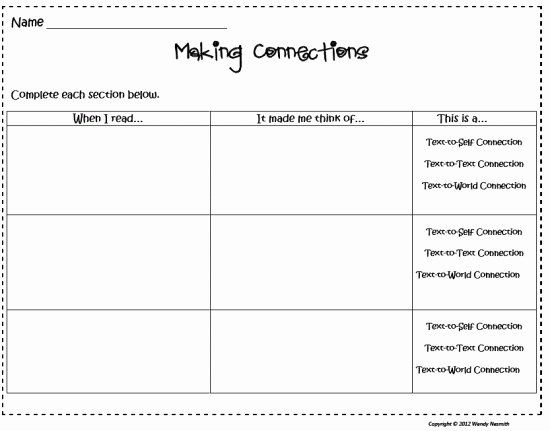 One that feels right in the moment, but isn’t true.
One that feels right in the moment, but isn’t true.
But realizing your initial thoughts aren’t true isn’t always enough reason to change them.
Why?
Because your thoughts are actually serving you in some way.
There ARE advantages in holding onto all-or-nothing thinking, like:
- You don’t have to face the discomfort of sticking to a meal plan.
- You don’t have to worry about finding a recipe to cook.
- You don’t need to plan your meals ahead of time. You can just grab what you want.
- You don’t have to tell your friends you’re not going out to grab a drink.
- You don’t have to find time to exercise.
Those were five reasons, but we can keep going! It’s easy to list 10, 20, or even 30 reasons why you might want to hold onto all-or-nothing thinking.
In fact, if the advantages outweigh the disadvantages, is it even helpful to change them?
- Maybe it’s worth keeping.
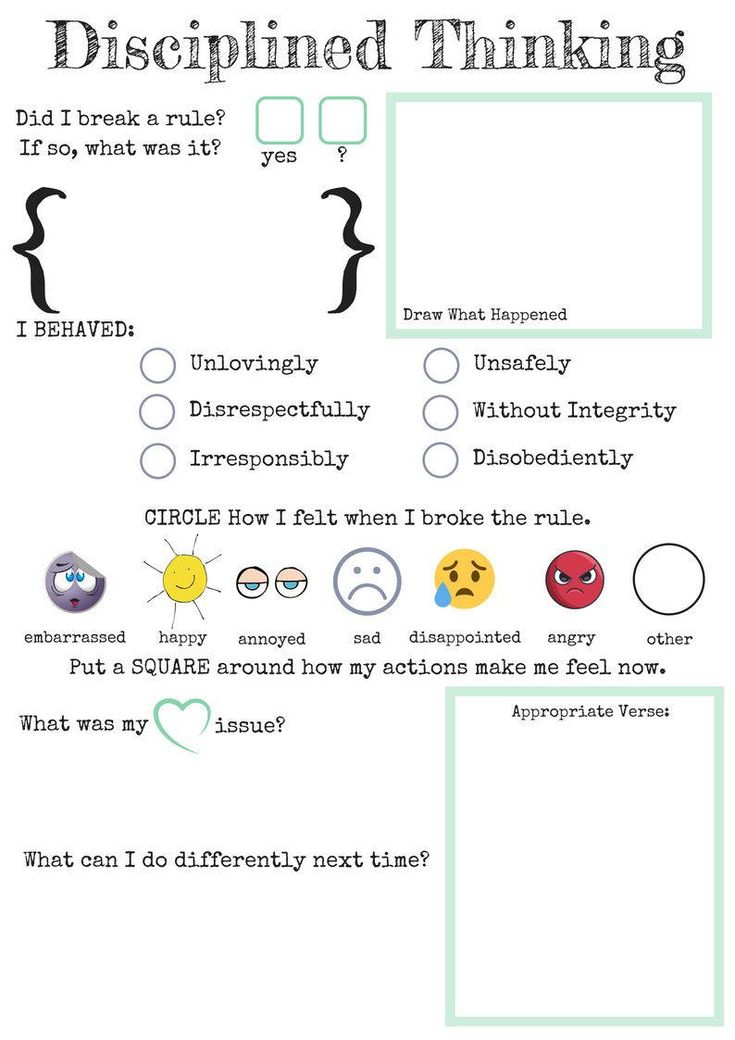
- Maybe you should stop at this step.
To help you decide whether you should keep going, answer this:
Is changing your belief really worth it, or are there simply too many advantages that you’ll give up?
If it’s truly worth it, let’s continue.
Step 7: Choose a new thought.The goal of this step is to find a replacement Thought. One that will help you create the emotions you need to drive you to your goal.
One way to do that is to start with the action you want to take and work backward to the thought that will get you there.
Say your desired action is to stick to your diet. Which emotions would you need to feel in order to accomplish that?
Maybe you would need to feel optimistic, eager, confident, or interested.
- Optimistic – that you are hopeful that you can keep your diet going even with so much on your plate.
- Eager – to prove to yourself you can make this happen.
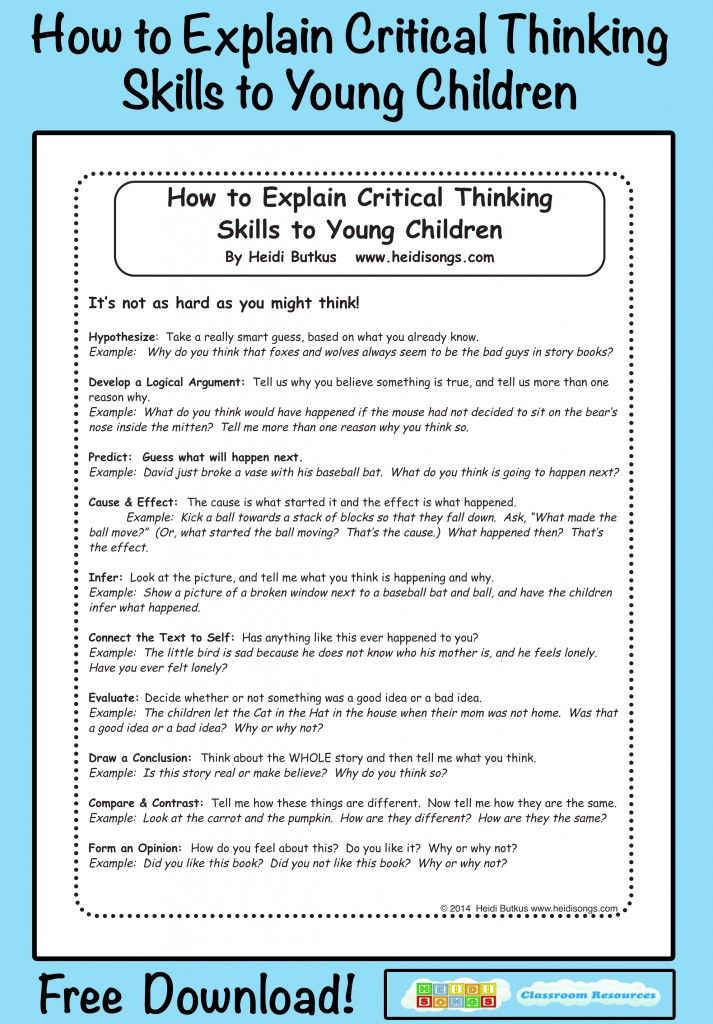
- Confident – in the plan you created to make improving your health manageable.
- Interested – to see how the upcoming week will go.
Next, brainstorm a list of thoughts you need to think to trigger those emotions?
Thoughts like:
- The goal is progress, not perfection.
- If I fail, at least I’m failing forward.
- Mistakes are proof of progress.
- I’ve never been one to turn down a challenge.
- I don’t look back and I don’t look forward. Right now, the only thing that matters is focusing on this one choice.
Write down thoughts that you can actually believe and get behind.
Change Your Thoughts, Change Your ActionsWhen you change your thoughts, you change how you feel. And when you change how you feel, you change how you act.
Are you ready to put in the work to change your thoughts?
If there were an easy button, I would give it to you.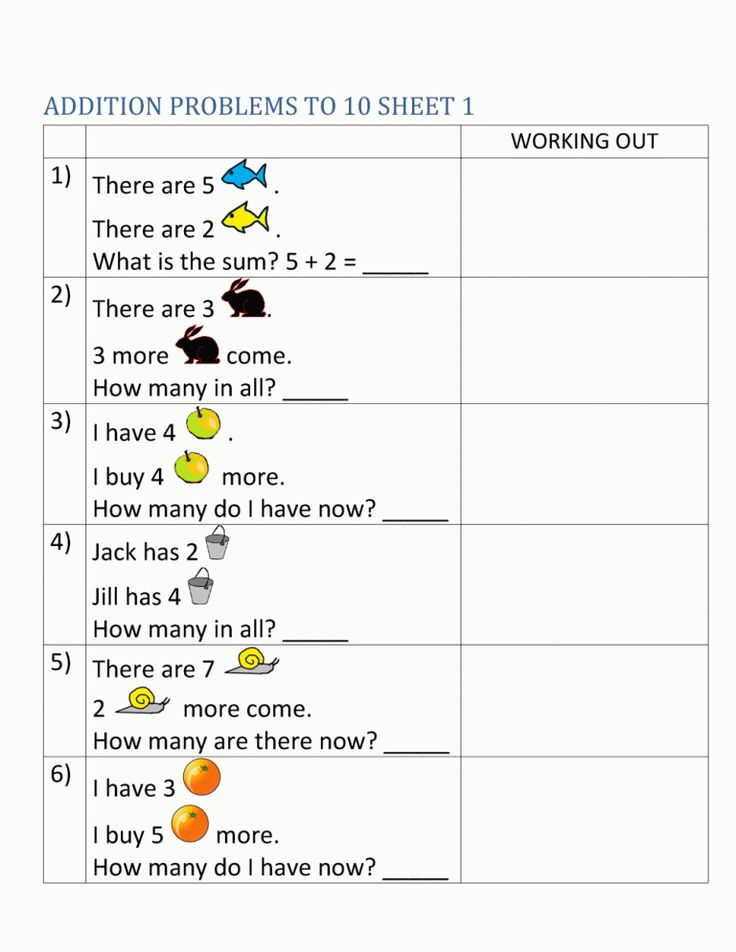 But the truth is: moving away from self-sabotaging thoughts to those that drive action isn’t an overnight process. It takes daily, consistent action. And if you’re ready to take that challenge, we can give you the daily support and accountability you need to put all-or-nothing thinking behind you.
But the truth is: moving away from self-sabotaging thoughts to those that drive action isn’t an overnight process. It takes daily, consistent action. And if you’re ready to take that challenge, we can give you the daily support and accountability you need to put all-or-nothing thinking behind you.
More Stories For You
CBT Worksheets | Therapist Aid
Facts are verifiable statements. They are supported by evidence and can be agreed upon. Opinions are personal interpretations of facts, which differ from person to person. For example, it is a fact that the sky is blue, and an opinion that the weather is beautiful. During cognitive behavioral therapy (CBT), it is important to separate facts from opinions...
The cognitive triangle illustrates how thoughts, emotions, and behaviors affect one another. This idea forms the basis of cognitive behavior therapy (CBT).
Perhaps most important to CBT, when a person changes their thoughts, they will also change their emotions and behaviors.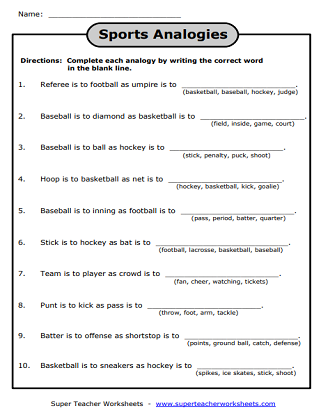 By targeting irrational or maladaptive thoughts, mood and behavior can be improved...
By targeting irrational or maladaptive thoughts, mood and behavior can be improved...
Become a member of Therapist Aid to unlock customizable versions of worksheets. Our subscribers use customizable worksheets to tailor examples for their unique populations, add professional branding and contact information, and make small tweaks to better suit their personal counseling style.
When people worry, they tend to imagine the worst thing that could possibly happen. In reality, these worries may never come true. What could happen isn’t the same as what will happen. In the Worry Exploration Questions worksheet, clients are asked to consider their worry versus reality. Through a series of Socratic questions, they are encouraged to explore the most likely outcomes for their worried-about situation, rather than the worst imaginable outcomes....
Core beliefs are a person’s most central ideas about themselves, others, and the world. These beliefs act like a lens through which every situation and life experience is seen.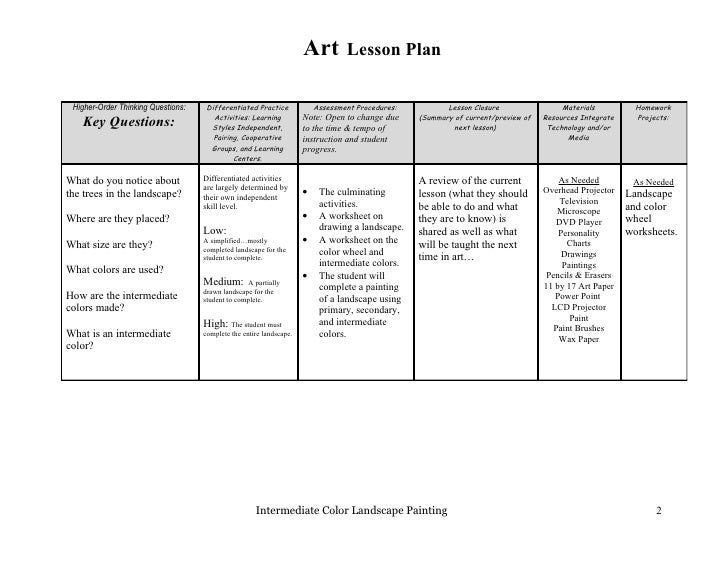 In cognitive behavioral therapy (CBT), core beliefs are thought to underlie automatic thoughts.
The Core Beliefs Info Sheet includes a simple definition of core beliefs, along with examples showing how they affect thoughts, behaviors, and feelings....
In cognitive behavioral therapy (CBT), core beliefs are thought to underlie automatic thoughts.
The Core Beliefs Info Sheet includes a simple definition of core beliefs, along with examples showing how they affect thoughts, behaviors, and feelings....
When the evidence that underlies core beliefs is challenged, the core beliefs can be changed. However, this can be difficult, because not all evidence is treated equally. Information that supports a core belief is easily integrated, making the belief stronger. Information that does not support a belief tends to be ignored...
The term cognitive restructuring refers to the process of challenging, and changing, irrational thoughts. Socratic questioning is one technique to encourage this process. Therapists use Socratic questioning verbally by asking probing questions about their clients' irrational thoughts. As clients improve their awareness of irrational thoughts, they can begin to consciously question their own thoughts.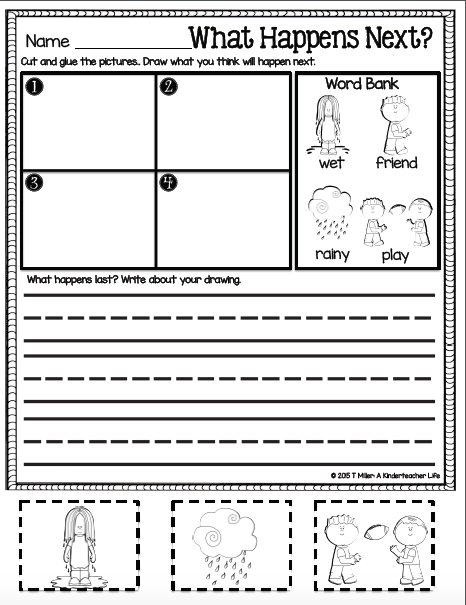 ..
..
Our thoughts and beliefs determine how we feel, and how we act, at any given moment. Even thoughts that are irrational, or lack evidence, impact our mood and behavior. A behavioral experiment is a CBT tool for testing our thoughts and beliefs, and replacing those that are irrational and harmful with healthy alternatives...
Early in cognitive behavioral therapy (CBT), clients will learn the cognitive behavioral model, and begin recording their experiences in a thought log. For many, the jump between these two tasks is difficult. The Cognitive Model: Example & Practice worksheet was designed to bridge this gap. In this CBT worksheet, the model is illustrated alongside an example, with space for your client to record a real-life example of their own...
A cost/benefit analysis is a classic technique for decision-making. In cognitive behavioral therapy (CBT), this technique has been adapted for use in cognitive restructuring. Put more simply, a cost/benefit analysis can be used to challenge old, unhealthy patterns of thinking, allowing them to be replaced by new, more adaptive thoughts.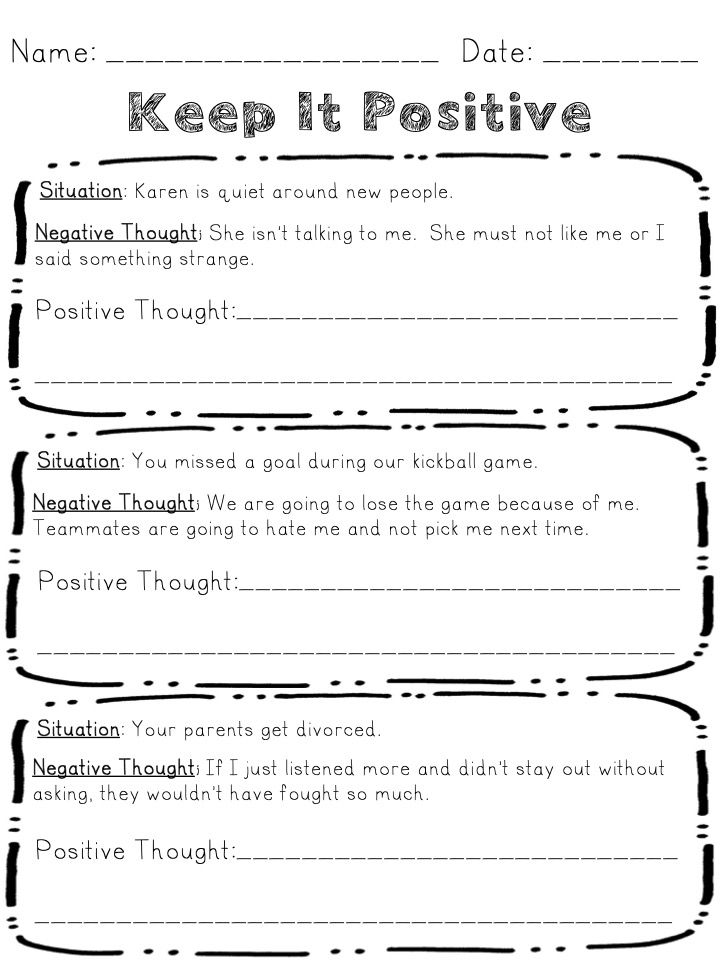 ..
..
Cognitive behavior therapy (CBT) is an evidence-based treatment for many mental and behavioral health issues. Research has shown that CBT can be effective for children as young as 7 years old, if the concepts are explained in a simple and relatable manner. Thoughts, Feelings, & Actions is a colorful and inviting 4-page CBT worksheet packet for children and adolescents...
How different types of thinking distort our assessment of what is happening around
Erroneous statements, which become a kind of filter for our perception of reality, most often appear due to the peculiarities of upbringing, complex emotional experiences and life experience. We must learn to understand the distortions of our thinking in order to more flexibly recognize the surrounding reality.
1. Black and white thinking (dichotomous)
Black and white thinking has different names - polar thinking or all-or-nothing thinking. But the essence is the same: a person uses only two categories to evaluate events, people and actions - “good” and “bad”.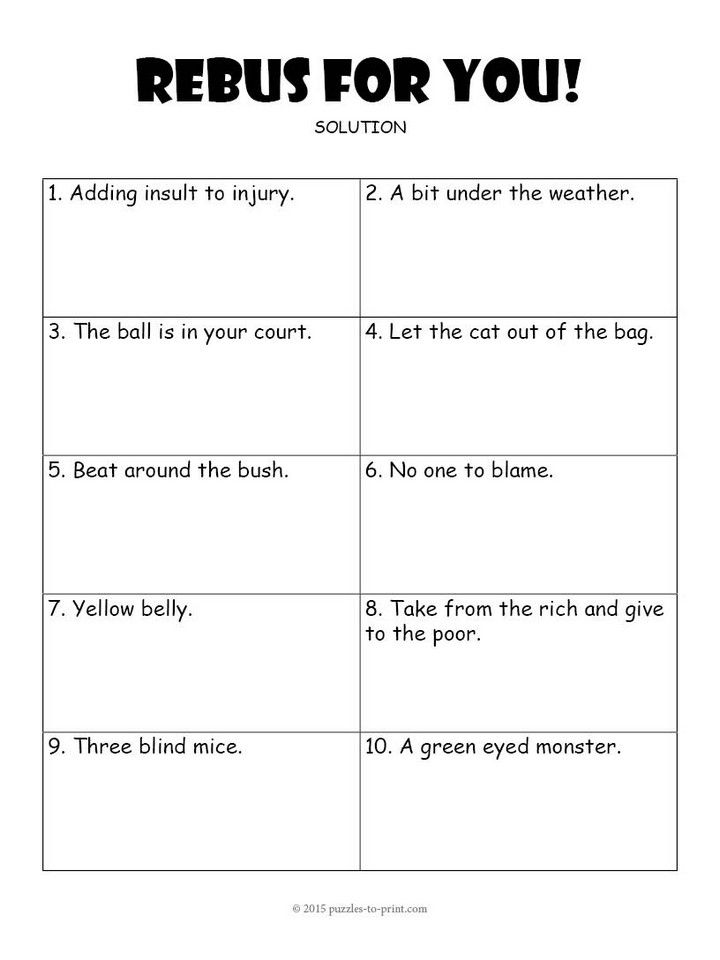 There is nothing in between. You either do it right or you don't; either you are a successful person, or a loser in life.
There is nothing in between. You either do it right or you don't; either you are a successful person, or a loser in life.
For themselves, people with black-and-white thinking often set the bar too high, evaluating themselves according to the principle “if I am not the first in everything, then I am a loser.”
2. Thinking with the devaluation of a positive result
In other words, this is when you reduce the importance of your success, positive experience and actions. For example, you did a difficult task well, but do not attach due importance to it. Most likely, you will say: “Yes, I succeeded, but this does not mean at all that I am smart and capable. I was just lucky".
3. Catastrophic thinking
This peculiarity of thinking can be compared with the actions of fortune-tellers and psychics - only you find yourself in the role of a predictor of the future. And you “see” only its negative aspects. You get so carried away with building the worst-case scenario that you simply stop noticing other, more likely outcomes of events.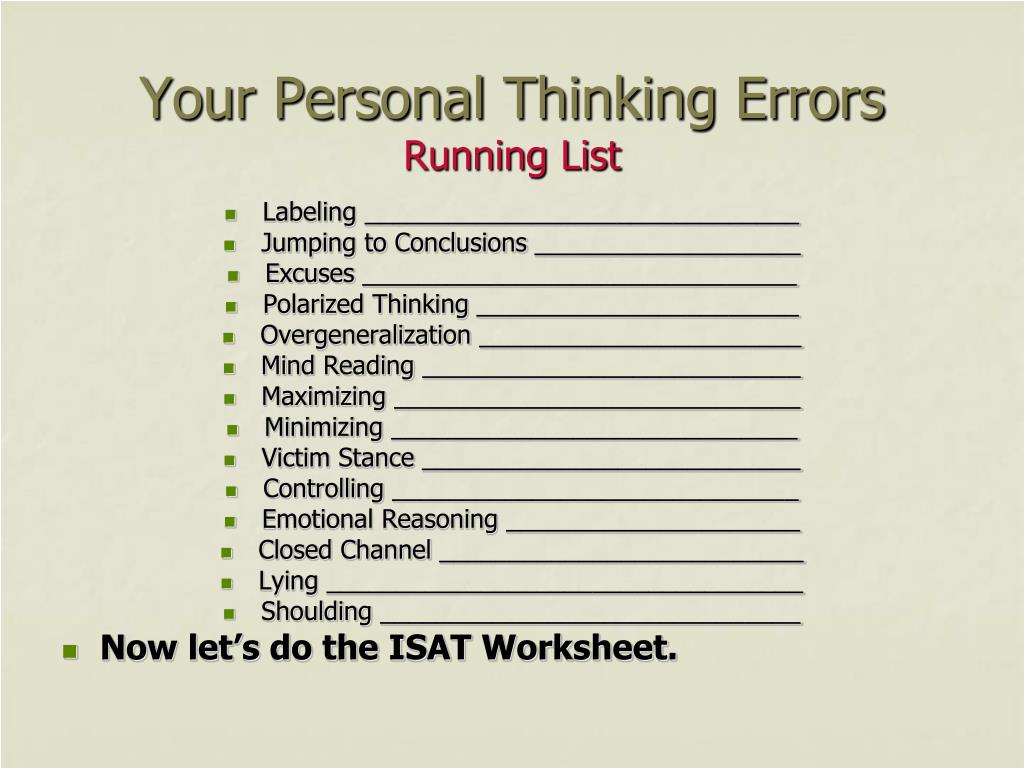 A typical example of catastrophizing is when you are sure that your work project is not good enough, and you predict various troubles for yourself after its presentation, from ridicule of colleagues to dismissal.
A typical example of catastrophizing is when you are sure that your work project is not good enough, and you predict various troubles for yourself after its presentation, from ridicule of colleagues to dismissal.
5 thinking mistakes that let you down every day
4. Emotional Reasoning
Have you heard that self-belief is power? Now, this is all true. And partly it has to do with emotional justification. You yourself convince yourself that any knowledge cannot be true just because you “feel” that way (in fact, you believe). Because you strongly believe this, you ignore or discount all evidence to the contrary. For example, you know you're just as good at your job as your co-workers, but you keep telling yourself you're really a failure because you feel like you are.
5. Labeling Thinking
We all love labeling ourselves and those around us before we fully understand the reasons for our actions and without taking into account the evidence that can lead us to less negative conclusions. Hence, among our acquaintances are “bore”, “henpecked” and “losers”. And we don’t forget about ourselves either: if something goes wrong, we already keep a couple of offensive words in our heads.
Hence, among our acquaintances are “bore”, “henpecked” and “losers”. And we don’t forget about ourselves either: if something goes wrong, we already keep a couple of offensive words in our heads.
6. Evaluation with underestimation of positive and exaggeration of negative results
In other words, a person with such a mindset will be very categorical in his assessments. When something bad happens in his life, he will elevate it to the category of apocalyptic events, and he can easily ruin any good moment by simply devaluing it. Example: "Just because I got an A on this exam doesn't mean I'm smart" or "Only those who can't work properly receive comments from bosses."
7. Mind reading
No, and this is not about psychics either, unfortunately. This is about a person who is sure that he knows the thoughts of other people. If something didn’t work out for him and his acquaintance or colleague turned out to be nearby, he is likely to think: “Now he will decide that I don’t understand anything about this.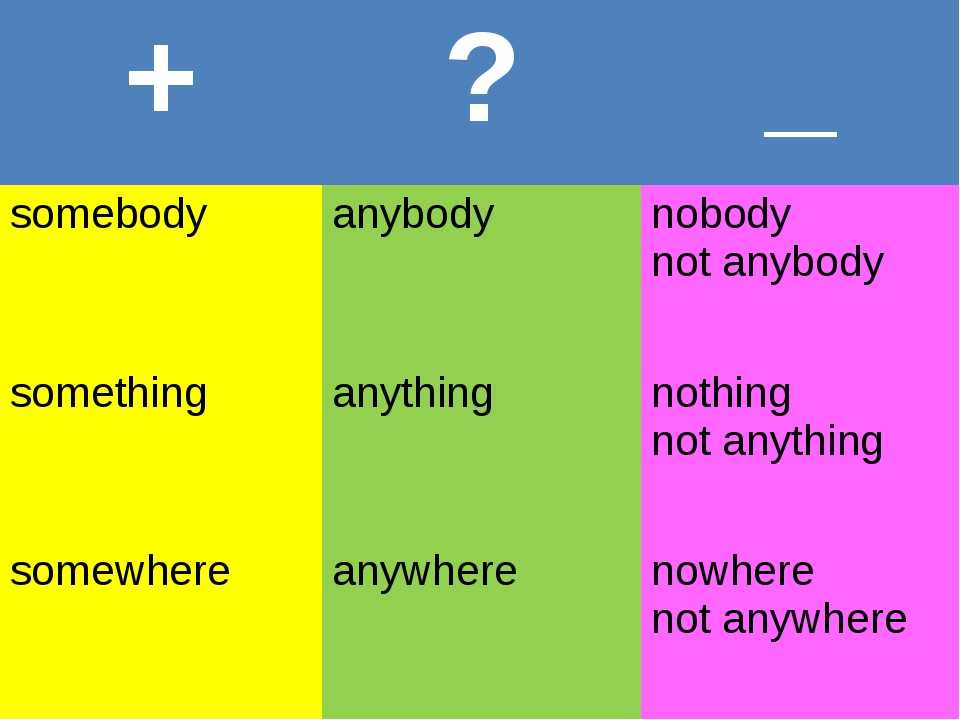 ” It is extremely difficult to dissuade a person from such conclusions, and often it is also pointless.
” It is extremely difficult to dissuade a person from such conclusions, and often it is also pointless.
8. Thought filter
Otherwise, this type of thinking is called selective abstraction. A person takes into account only the negative events of his life - failures, defeats, mistakes and hardships. The full picture of what is happening is inaccessible or uninteresting to him. So it turns out that just one bad result means much more for a person than a dozen good ones.
9. Personalization
In other words, a person believes that he is the cause of the negative behavior of the people around him. He is sure that his mistakes and miscalculations are the object of everyone's attention. For example, if a saleswoman in a store is rude to such a person, he will first of all think about what he could do wrong.
10. Must
This is “I must” thinking, which not only refers to the behavior of the person himself, but also limits the actions of those around him.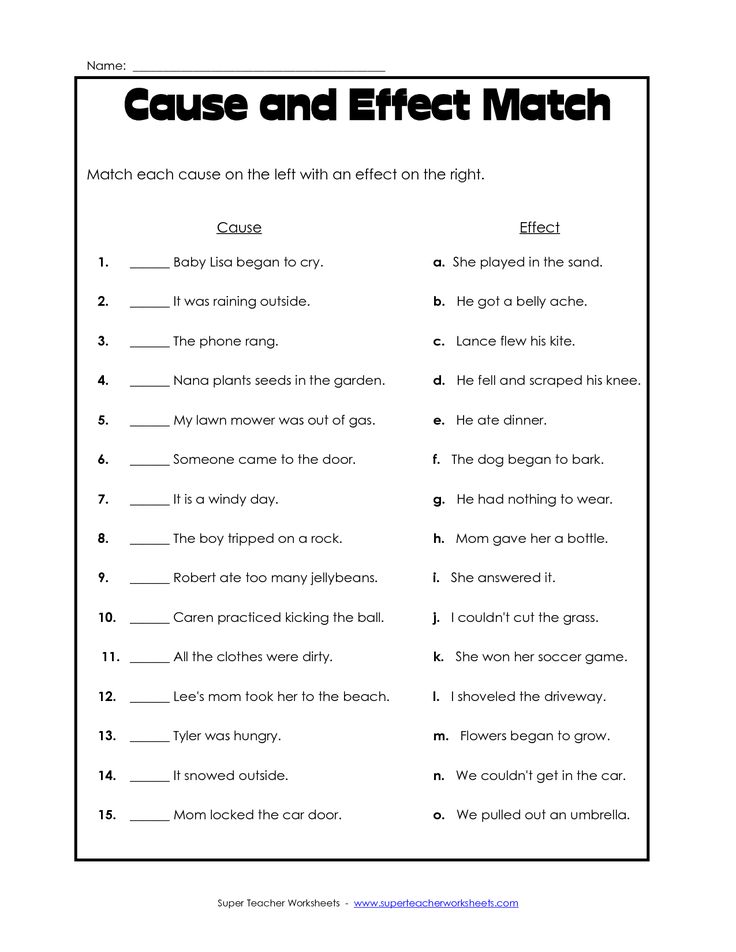 He believes that he knows how people should behave, and if his expectations are not met, he is deeply disappointed. The unjustified expectations that he made of himself, a person can regard as a personal failure. For example: “I'm sorry I made a mistake. I have to be successful in everything."
He believes that he knows how people should behave, and if his expectations are not met, he is deeply disappointed. The unjustified expectations that he made of himself, a person can regard as a personal failure. For example: “I'm sorry I made a mistake. I have to be successful in everything."
10 things you shouldn't make excuses for
11. Tunnel thinking
A person focuses only on the negative aspects of a situation, not wanting to see its positive aspects. Very often, when a person with tunnel thinking begins to criticize someone, he clings to new and new facts that only aggravate the idea of his interlocutor as a person/specialist, etc.
12. Overgeneralization
People with this type thinkers are accustomed to formulate generalizing negative conclusions that go beyond the scope of the situation under consideration. For example, they can explain their inability to meet new people by feeling unwell, etc.
Other articles on topics:
Psychology
Cognitive installations in thinking
Content
- 20 cognitive distortions and how they affect our life
- 1.
 Black and white thinking
Black and white thinking - 2. Personalization
- 3. Hypertrophied sense of duty
- 4. catastrophe
- 5. exaggeration
- 6. understatement
- 7. telepathy
- 8. clairvoyance
- 9. generalization
- 10. Depreciation
- 11. Selective perception
- 12. Hungry of labels
- 13. The habit of accusing
- 14. Emotional determination
- 15. Illusion of own rightness
- 16. Summary attribution
- 17. WEED AND WEEDING "FIRST Awards"
- 18. The illusion of change
- 19. Belief in justice
- 20. The illusion of control
- 0076
- “Back home at 33: what I learned in two years of living with a toxic mother”
- Cognitive thinking: what is it and how to develop it?
- Features
- Principles
- Development
- Main errors
- Thinking in the framework of the “All or nothing” template
- Generalization of private cases
- Excessive dramatization
- Non -rejection of the RESULATIONALS NECED DESTRICTIONS FRIENCE OF THE RESULTS0004 20 cognitive distortions and how they affect our lives
- The demonstrative type is aimed at solving certain problems related to constructability, production and organization of activities. It is inherent in children under 3 years old, whose cognitive process is inextricably linked with the use of hands.
- Visual-figurative view transforms generalized thoughts into specific images.
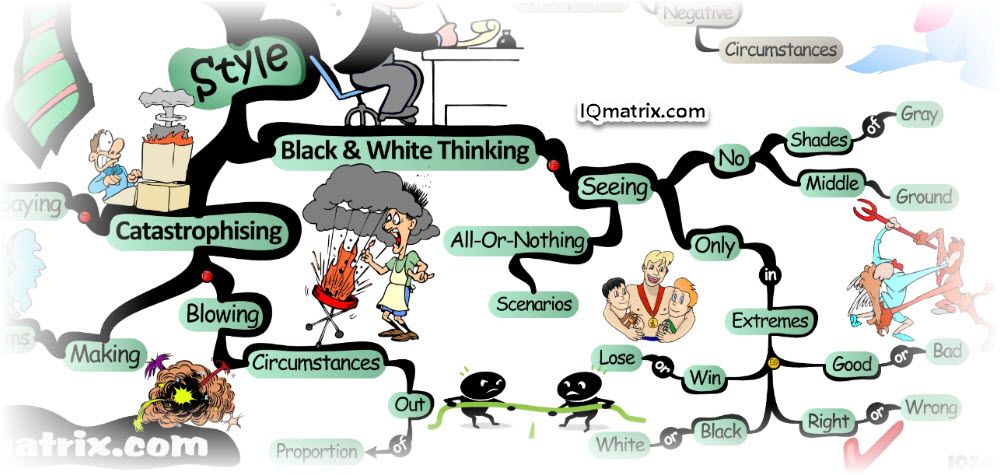 It is formed in children from 4-7 years old. At this time, the connection of consciousness with practical movements is not as strong as before.
It is formed in children from 4-7 years old. At this time, the connection of consciousness with practical movements is not as strong as before. - Abstract thinking is associated with abstract reasoning. It is observed in schoolchildren and adults who can operate with generalized concepts, devoid of direct visualization and images.
- Representatives of the simple style of cognitive thinking interpret the ongoing processes in a simplified form. Owners of a complex style tend to be multidimensional when perceiving existing concepts and identifying many interrelated aspects in them.
- Owners of concrete mental activity do not tolerate uncertainty, depend on status and authority . They have black and white thinking, stereotyped decisions. People with abstract cognitive thinking are prone to risk, independence, and flexibility.
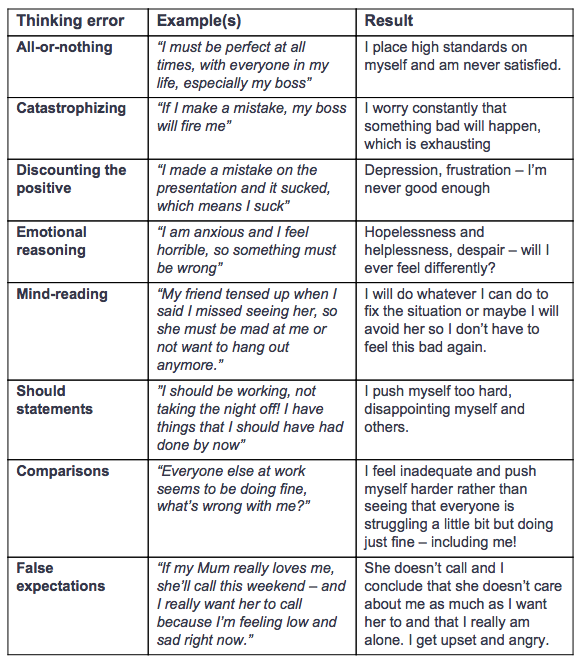 They have a wide range of concepts.
They have a wide range of concepts. - People with an analytical style pay attention to the difference in objects, fixate on their distinguishing features, the smallest elements. The synthetic style is inherent in individuals who tend to focus on the similarity of information and find common features in them.
- Impulsive style people tend to make instant decisions when they have a choice. Haste often leads to mistakes. Those with a reflective style act in slow motion when making decisions, so the occurrence of errors is minimized.
- Some people have a wide distribution of attention to many details at the same time . Such individuals are able to scan the displayed situation. Other individuals can only superficially, fragmentarily characterize the facts and phenomena that caught their eye. They have the ability of narrow control, which is called the focusing style.
- Tolerant subjects are able to accept ambiguous events that do not correspond to the ideas of a person.
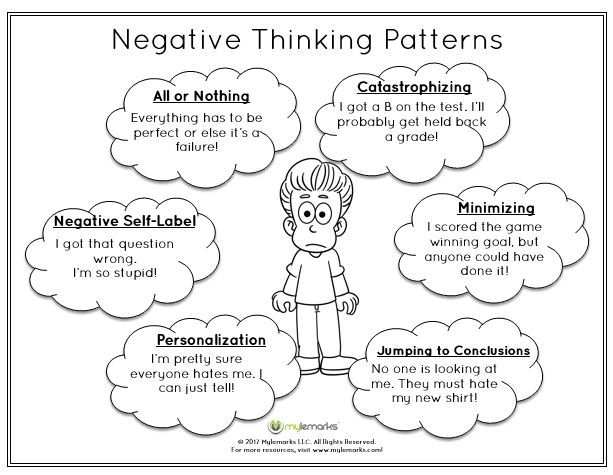 They can analyze them according to their characteristics. Intolerant people are not ready to receive cognitive experience, where there is information that contradicts their knowledge.
They can analyze them according to their characteristics. Intolerant people are not ready to receive cognitive experience, where there is information that contradicts their knowledge. - The concept of unconscious thought is based on conscious and unconscious types of thinking. Conscious thinking is associated with cognitive action aimed at the task or subject that is in the center of attention. In the unconscious thought process, events are outside the focus of the thinking individual.
- The law of capacity implies the storage of no more than 7-9 elements of information in the working memory. This rule does not apply to the unconscious mind.
- The "top down" and "bottom up" aspects testify to the issuance of a ready-made solution by the subconscious sphere after absorbing the facts as a whole, while conscious thinking processes data systematically through various schemes and definitions.
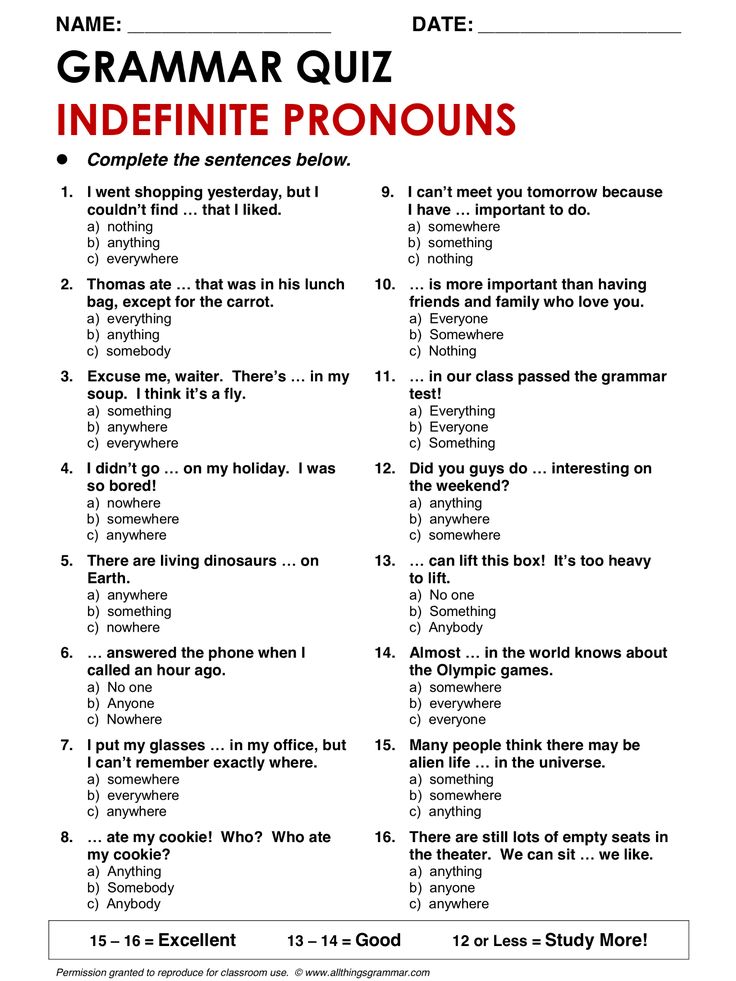
- The principle of weightiness is that the best decisions are made by people in moments of some distraction from the important and difficult tasks. Consequently, unconscious thinking is often more effective than conscious reasoning.
- The principle of rule states that the answers found at the unconscious level do not always correspond to the laws of logic, since they are based on associations. Conscious decisions are always based on formal rules.
- The principle of rapprochement (convergence) involves insight into the essence of the problem and forgetting about it. Then the unconscious mind comes into play and the impasse is easily resolved. Some cooperation is formed between conscious and unconscious thinking.
- games of checkers, chess, backgammon, poker;
- assembly of puzzles, Rubik's cube;
- solving crossword puzzles, rebuses, charades;
- solving mathematical problems;
- various games in "words", "cities";
- study of a foreign language with the establishment of a connection with the native language, the search for associations;
- reading books with an analysis of each page read and fantasizing about further events.
Worldview is not determined by circumstances. We ourselves choose our attitude to everything that happens around us. What is the difference between someone who remains optimistic despite many adversities and someone who is angry at the whole world for pinching his finger? It's all about different patterns of thinking.
We ourselves choose our attitude to everything that happens around us. What is the difference between someone who remains optimistic despite many adversities and someone who is angry at the whole world for pinching his finger? It's all about different patterns of thinking.
In psychology, the term "cognitive distortion" is used, which means an illogical, preconceived conclusion or belief that distorts the perception of reality, usually in a negative way. The phenomenon is quite common, but if you do not know what it is expressed in, it is not easy to recognize it. In most cases, this is the result of automatic thoughts. They are so natural that a person does not even realize that he can change them. It is not surprising that many take a fleeting assessment for an indisputable truth.
Cognitive distortions cause serious harm to mental health and often lead to stress, depression and anxiety. If action is not taken in time, automatic thoughts become fixed as patterns and can adversely affect behavior and decision-making logic.
Anyone who wants to maintain a healthy psyche would do well to understand how cognitive distortions work and how they affect our worldview.
1. Black and white thinking
A person with dichotomous thinking perceives the world from the position of “either/or”, there is no third way. Good or bad, right or wrong, all or nothing. He does not admit that between black and white one can almost always find at least a few shades of gray. Anyone who sees people and events from only two sides refuses to accept intermediate (and most often the most objective) assessments.
2. Personalization
People with this type of thinking tend to overestimate their own importance and take many things personally. Other people's behavior is usually seen as a consequence of their own actions or deeds. As a result, those who are prone to personalization take responsibility for external circumstances, although nothing really depended on them.
3. Hypertrophied sense of duty
Attitudes like “should”, “must”, “should” are almost always associated with cognitive distortions.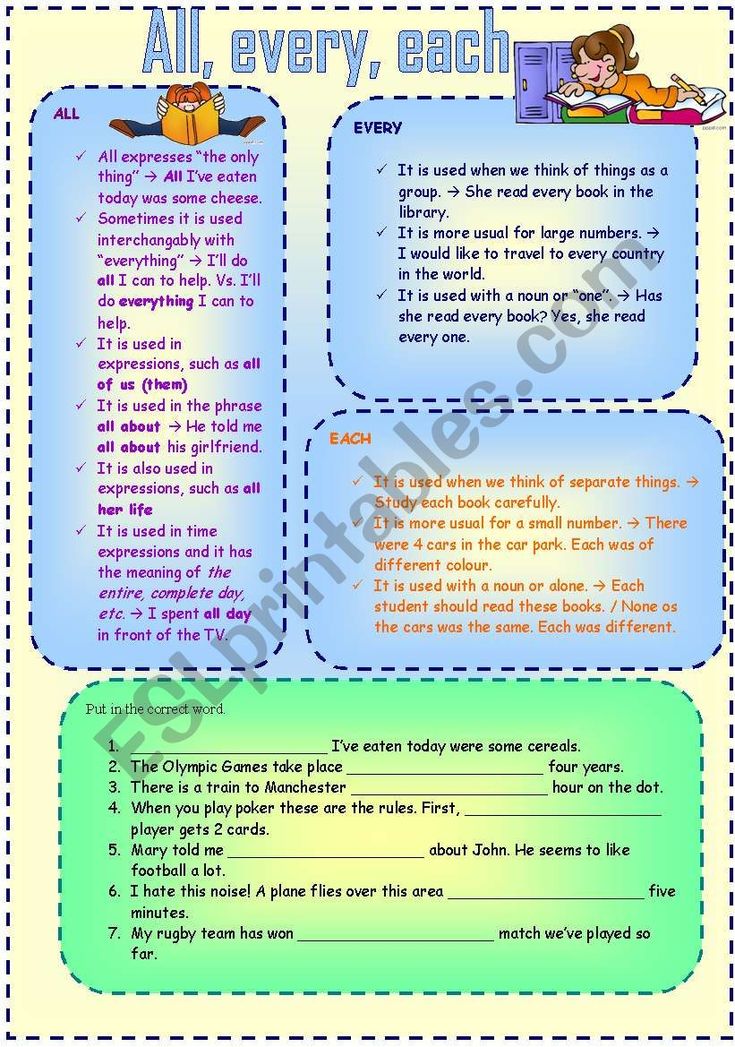 For example: "I had to come to the meeting early", "I have to lose weight to become more attractive." Such thoughts cause feelings of shame or guilt. We treat others no less categorically and say something like: “he should have called yesterday”, “she is forever indebted to me for this help.”
For example: "I had to come to the meeting early", "I have to lose weight to become more attractive." Such thoughts cause feelings of shame or guilt. We treat others no less categorically and say something like: “he should have called yesterday”, “she is forever indebted to me for this help.”
People with such beliefs are often upset, offended and angry at those who do not live up to their expectations. But with all our desire, we are not able to influence someone else's behavior, and it's definitely not worth thinking that someone "should".
4. Catastrophization
This is the habit of perceiving any minor annoyance as an inevitable disaster. Let's say a person fails one exam and immediately imagines that he won't finish the course at all. Or the exam is still ahead, and he "knows" in advance that he will certainly fail, because he always expects the worst - so to speak, "advance" catastrophization.
5. Exaggeration
With such a cognitive distortion, everything that happens is inflated to a colossal scale. The case resembles a catastrophe, but not so severe. It is best described by the saying "make an elephant out of a fly."
The case resembles a catastrophe, but not so severe. It is best described by the saying "make an elephant out of a fly."
6. Understatement
Those inclined to exaggerate everything easily underestimate the significance of pleasant events. Two opposite distortions often end up in the same bunch. People think something like this: “Yes, I was promoted, but just a little bit - it means that they don’t appreciate me at work.”
7. Telepathy
People with this mindset attribute psychic abilities to themselves and believe they can read others like an open book. They are confident that they know what the interlocutor is thinking, although guesses are rarely true.
8. Clairvoyance
The so-called "clairvoyants" try to predict the future, usually in a black light. For example, without any reason they say that everything will end badly. Before a concert or a movie show, they usually say: “We don’t have to go anywhere, I have a presentiment that the tickets will run out in front of our noses.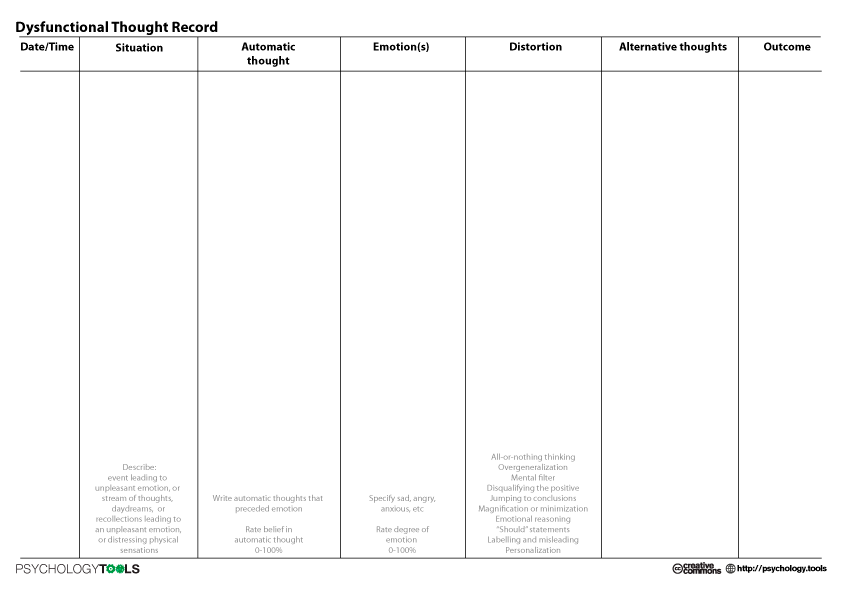 ”
”
9. Generalization
The tendency to generalize means the habit of drawing conclusions from one or two cases and denying that life is too complicated for hasty conclusions. If a friend does not come to a meeting, this does not mean that he is not able to fulfill the promise at all. In the vocabulary of a person prone to make such a cognitive error, the words “always”, “never”, “always”, “every time” are often found.
10. Depreciation
This is an extreme form of “all or nothing” thinking, which manifests itself in a tendency to devalue any achievements, events, experiences (including one's own) and to see everything as negative. A person with such stereotypes usually neglects compliments and praise.
11. Selective perception
Cognitive distortion, similar to the previous one, is expressed in the habit of filtering any information and choosing the “appropriate” statement. For example, a person reads his/her school testimonial or employer's recommendation, excludes all the good ones and fixates on a single critical remark.
12. Labeling
A more rigid kind of generalization means that a person evaluates himself and others on the basis of a single case. It is easier for him to automatically label himself as a loser than to recognize someone's right to make a mistake.
13. The habit of blaming
The other side of personalization. Instead of blaming yourself for mistakes, it is more convenient to shift the blame to others or an unforeseen situation.
14. Emotional conditioning
This is the name of the erroneous sensory perception of reality. If I'm scared, then there's a real threat. If I think I'm stupid, then I am. Such thinking can indicate serious mental disorders - including pointing to obsessive-compulsive disorder. For example, a person feels dirty even though they have showered twice in the last hour.
15. Illusion of one's own rightness
Turns a private point of view into an indisputable fact and allows one to disregard the opinions and feelings of others. This makes it very difficult to create and maintain healthy relationships.
This makes it very difficult to create and maintain healthy relationships.
16. Self-serving attribution
It is expressed in the tendency to ascribe exclusively positive qualities to oneself and deny one's involvement in any unpleasant or undesirable events. A person with such a mindset refuses to admit his shortcomings and is absolutely confident in his own infallibility.
17. Waiting for a “divine reward”
There is a delusion that the higher powers will sooner or later appreciate our sacrifices. Under its influence, people neglect their interests and needs in the hope that someday they will be rewarded for their dedication. And since this never happens, they are overcome by anger and resentment.
18. The illusion of change
Consists of the belief that others must change in order to be happy. This is the mindset of an egomaniac who insists that others fit into his schedule, or demands that a partner not wear their favorite T-shirt because they don't like it.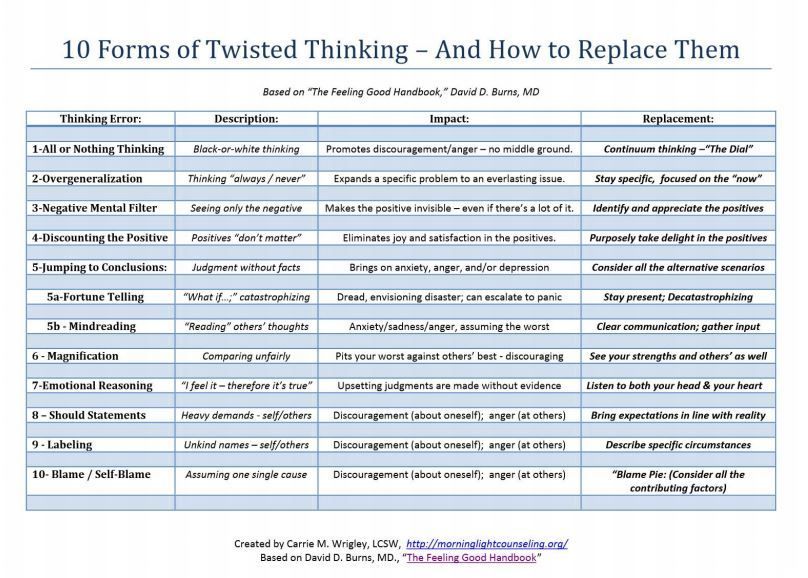
19. Faith in justice
The phenomenon is expressed in the idea of a just world in which everyone gets what they deserve, although in reality this rarely happens. An example of this mindset trap is blaming yourself for cheating on your partner.
20. Illusion of control
The one who thinks that everything in the world can be controlled is pissed off by someone else's behavior - for the simple reason that he cannot be influenced in any way. A person obsessed with the desire to control everything may blame the boss for the poor performance of the company, although the real problem may lie elsewhere.
HOW TO CORRECT THOUGHT PATTERNS AND COGNITIVE DISTORTIONS
Chances are you've found yourself with at least one of these cognitive distortions. Perhaps you or someone you know has fallen into similar traps more than once. The good news is that we are not bound to them forever.
Patterned thinking is changeable: this process is called cognitive restructuring.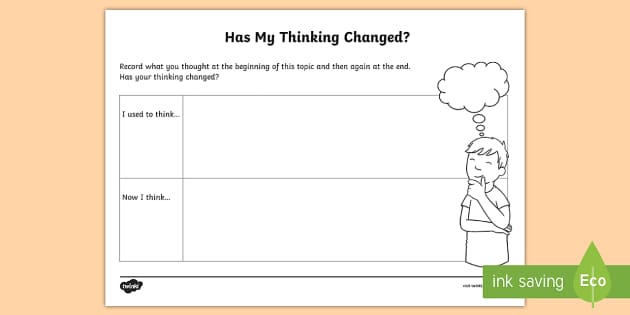 Its essence is that we can influence our own emotions and actions by correcting our automatic thoughts. Many popular forms of therapy are based on this concept, including cognitive behavioral therapy and rational emotive behavior therapy.
Its essence is that we can influence our own emotions and actions by correcting our automatic thoughts. Many popular forms of therapy are based on this concept, including cognitive behavioral therapy and rational emotive behavior therapy.
If you have one or more cognitive distortions and feel that they are causing anxiety, depression or other psychological problems, be sure to see a therapist. An experienced specialist will help transform negative attitudes into more constructive and inspiring beliefs.
Lateral thinking: finding a non-standard solution
In most cases, we think vertically: we choose the most promising approach to solving a problem and follow it. We disavow roads that can lead to the side, we act by the method of exclusion, we stick labels on objects, people and concepts. There are psychological barriers behind all this.
“Coming home at 33: what I learned in two years of living with a toxic mother”
Relationships with mothers are almost always a difficult story.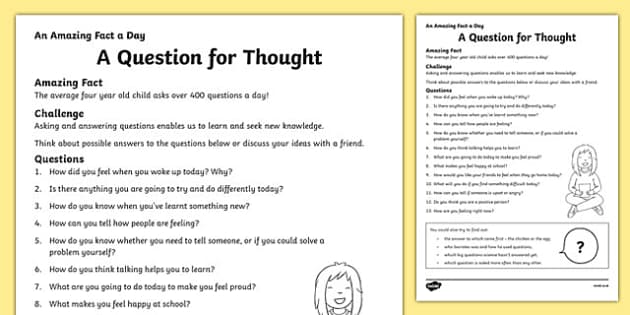 Tenderness and care in them is often mixed with a desire for dominance and control. But it can be quite difficult to notice how much the usual relationship script harms us in adult life. Our author shares his experience.
Tenderness and care in them is often mixed with a desire for dominance and control. But it can be quite difficult to notice how much the usual relationship script harms us in adult life. Our author shares his experience.
source
Cognitive thinking: what is it and how to develop it?
The thinking process involves some manipulation of knowledge, so it is referred to as a cognitive system. The transformation of information into the final product depends on the degree of cognitive actions of thinking.
Features
Cognitive science (from Latin cognitionis - knowledge) combines cognitive psychology, linguistics, neurophysiology, as well as the theory of cognition and artificial intelligence . The development of this science continues in several directions. The concept of biological evolution by Jean Piaget, the theory of rational thinking with the inclusion of the process of converting external actions into internal mental functions by Lev Vygotsky, and the informational approach to the system are taken as the basis. The mechanism of the brain structure is studied using a tomograph and other modern scanning methods.
The mechanism of the brain structure is studied using a tomograph and other modern scanning methods.
Cognitive thinking is inextricably linked with the cognitive process. It is responsible for the formation of concepts, decision-making and the development of reactions.
The type of cognitive mental activity depends on the personality, experience of interaction with other people. An important role is played by knowledge, ability to solve various problems, logic, attention, perception and memory of the individual.
In psychology, there are 3 types of such thinking.
The nature of cognitive thinking styles has not yet been fully studied. Consider some of them.
Principles
The cognitive system includes conscious and unconscious thinking. Researchers have identified 6 principles for separating one from the other.
Development
Cognitive thinking develops with the help of inner speech , therefore, the thought process depends on the language. Language and thought are inseparable.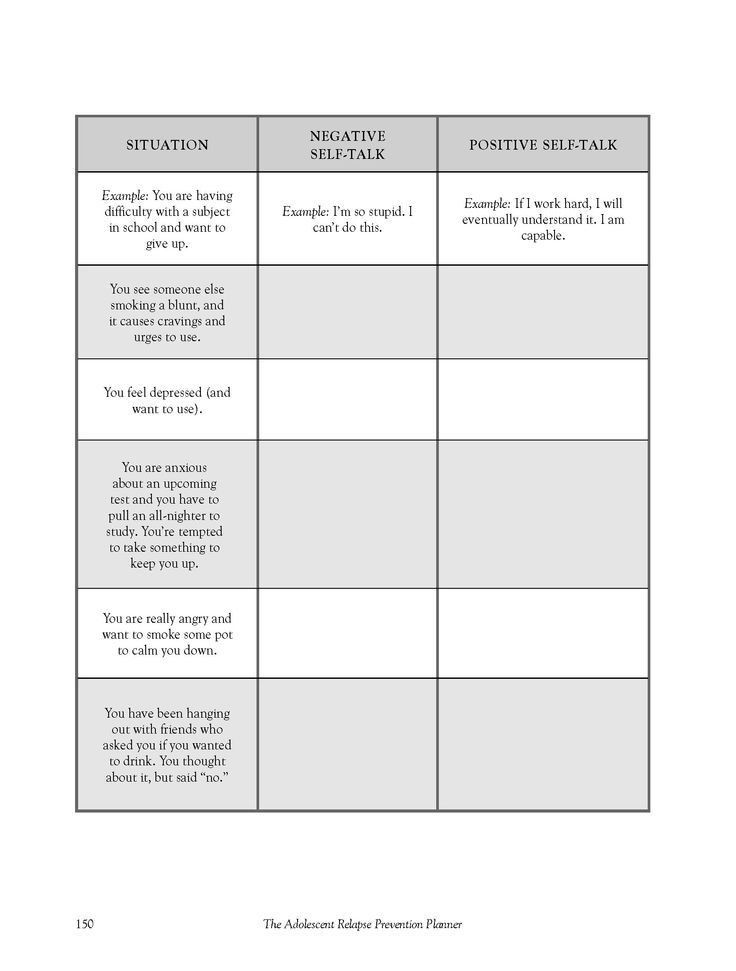 They must be trained daily, otherwise it is difficult to achieve good results.
They must be trained daily, otherwise it is difficult to achieve good results.
Proper nutrition is important. The brain must be supplied with plenty of vitamins and minerals. It is useful to eat nuts, vegetables, chocolate, eggs. Sports activities, walks in the fresh air have a positive effect on the development of cognitive mental activity.
Good for developing this type of thinking:
Synchronized drawing improves motor skills and improves eye coordination. Take a large piece of paper and hold a pencil in both hands. Then you need to start mirroring objects at the same time. With two hands, you need to draw circles, ovals, triangles, squares, rectangles and other objects.
Take a large piece of paper and hold a pencil in both hands. Then you need to start mirroring objects at the same time. With two hands, you need to draw circles, ovals, triangles, squares, rectangles and other objects.
The next task is reduced to continuous writing of eights. First, they are drawn alternately with the left and right hand, then synchronously with both hands. Then, along with the eights, a lowercase letter “a” is written, followed again by the numbers “8”. In the same way, the following letters of the alphabet are written interspersed with eights.
Experts recommend improving memory by looking at an old photo album. Development occurs along with the memories of past events.
All training exercises contribute to maintaining the tone of the brain throughout the day, increasing efficiency, maintaining a clear and sharp mind until old age.
Basic mistakes
Quite often the cognitive thought process leads certain beliefs to distortion.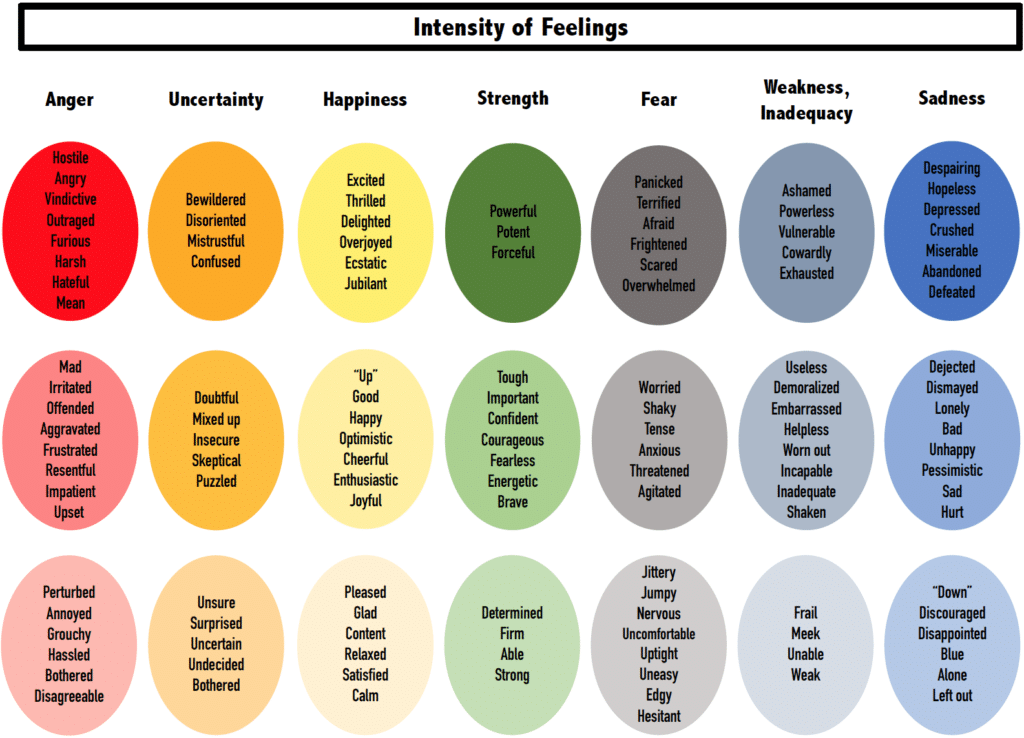 And then 9 appear0021 pattern deviations in thinking. For example, there are known cases of people's tendency to deny the opinions of strangers who are not part of their group, and to fully agree with like-minded classmates, even if the statements of those are unfounded and unjustified.
And then 9 appear0021 pattern deviations in thinking. For example, there are known cases of people's tendency to deny the opinions of strangers who are not part of their group, and to fully agree with like-minded classmates, even if the statements of those are unfounded and unjustified.
There are many errors associated with cognitive bias. We list the most common of them.
All-or-Nothing Thinking
Some people, especially perfectionists, tend to go to extremes. They believe that if a task is not 100% completed, then it is not ready. The call master came late, which means that he is a bad specialist, and you should not resort to the services of the company where he works anymore. If a dieter accidentally ate a pie, then there is no point in sticking to a dietary diet, since all efforts are reduced to zero.
Generalization of special cases
Any accidental misconduct is a reason to unreasonably transfer a single case to a cumulative action.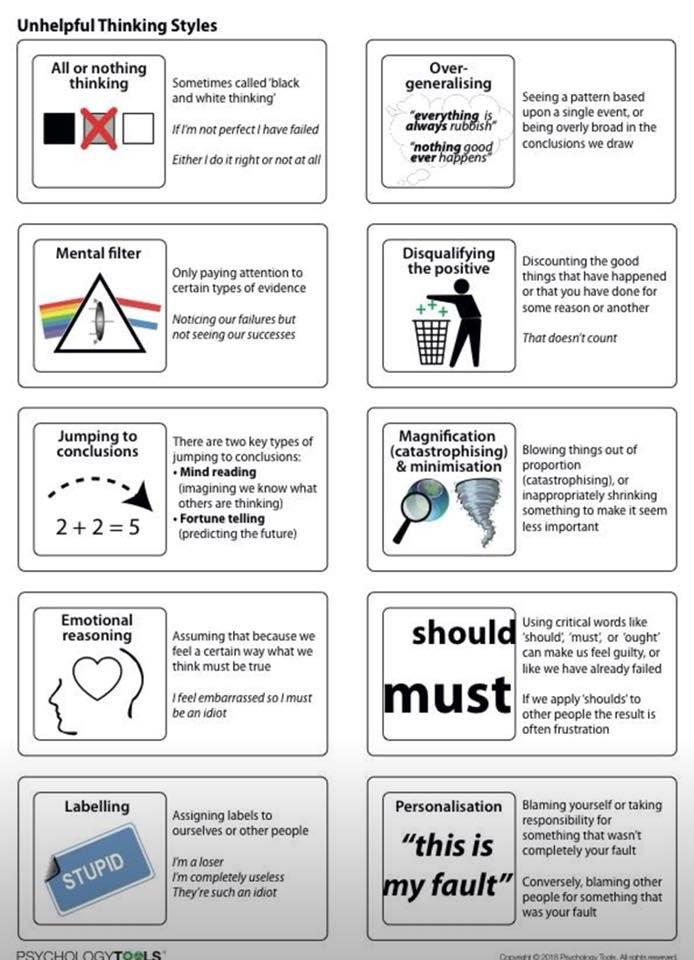 A single event leads people to conclude that this is always the case. Or, conversely, never. A person who has not submitted a report on time is worried that now he will never be promoted. The employee performed the order poorly, which means that he is a bad employee and always does a poor job with all tasks.
A single event leads people to conclude that this is always the case. Or, conversely, never. A person who has not submitted a report on time is worried that now he will never be promoted. The employee performed the order poorly, which means that he is a bad employee and always does a poor job with all tasks.
Over-dramatization
Sometimes some minor incident turns into a disaster. A novice jumper is slightly injured during a jump, after which he decides that this sport is not suitable for him, since he is unlikely to be able to land correctly.
Psychologists recommend keeping a diary in which you need to record all your fears. Be sure to highlight the positive and negative points.
Over time, a person begins to see positive moments and learns to get himself out of any unpleasant situations.
Sticking labels
Quite often in groups a strong opinion about some person is fixed because of a single specific event .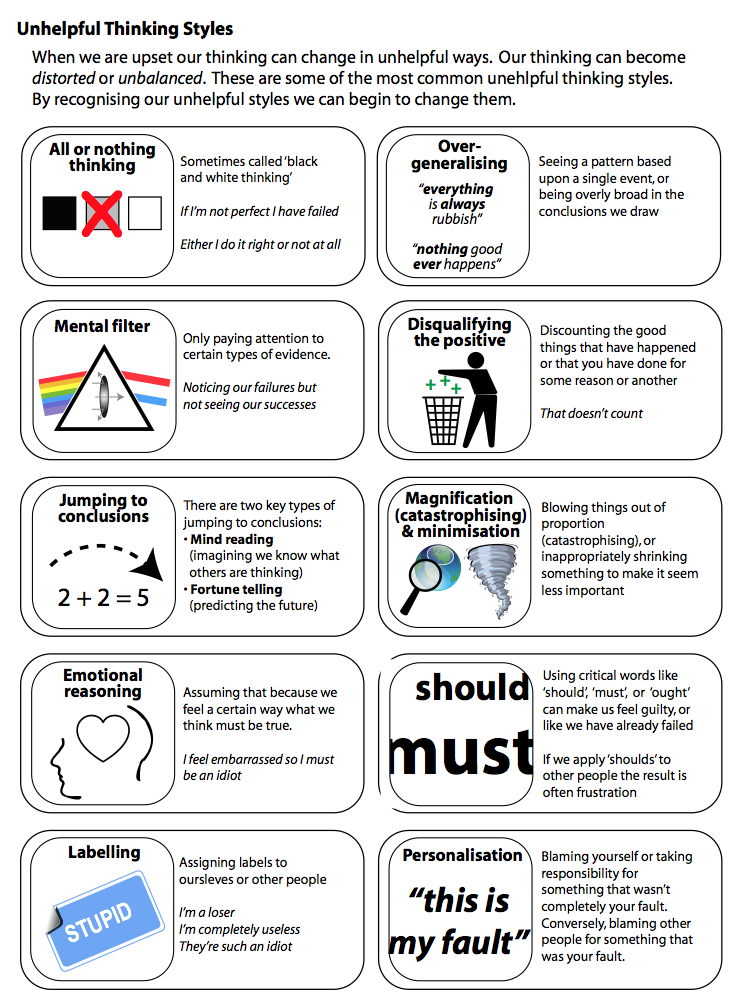 For example, a colleague at a corporate party got drunk. He is labeled as a drunkard. Although in fact, it could be an isolated incident that will never happen again. Another employee went deep into his own thoughts and did not greet those around him. He was immediately considered an arrogant ignoramus.
For example, a colleague at a corporate party got drunk. He is labeled as a drunkard. Although in fact, it could be an isolated incident that will never happen again. Another employee went deep into his own thoughts and did not greet those around him. He was immediately considered an arrogant ignoramus.
Labels give rise to negative emotions and distort reality. We must learn to objectively assess the situation, not relying on a single fact. Once a late person does not always demonstrate his indiscipline. You need to be able to separate emotions from concrete phenomena.
Unfounded conclusions
Sometimes a person takes on the function of conjecture and tries to read the thoughts of another person, making a conclusion about her negative attitude towards her person. A person unreasonably believes that he is being treated badly.
Quite often people without any reason predict future events not in their favor. For example, during a speech, the speaker made several mistakes that gave him reason to believe that now he will never be invited to the conference.